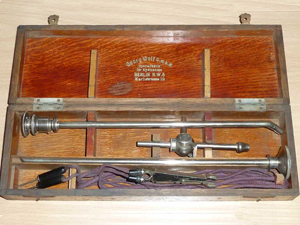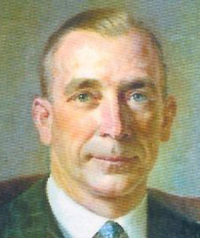The emergence of the speciality
The 20th century, punctuated by its two World Wars, saw unprecedented technological expansion. New technology in medicine led to urology finally becoming a speciality in its own right. This led to the formation of the first British urological association, the Urology Section of the Royal Society of Medicine in 1920, and then BAUS in 1945. The first British urology journal, the BJU began in 1929.
The cystoscope
 Although the cystoscope was an invention of the 19th century, it was at the begining of the 20th century that it first began to influence British urology. Pioneers such as Hurry Fenwick at The London Hospital and Canny Ryall at All Saints' Hospital promoted this new technology and left the world of Sir Henry Thompson and Sir Henry Morris behind.
Although the cystoscope was an invention of the 19th century, it was at the begining of the 20th century that it first began to influence British urology. Pioneers such as Hurry Fenwick at The London Hospital and Canny Ryall at All Saints' Hospital promoted this new technology and left the world of Sir Henry Thompson and Sir Henry Morris behind.
The cystoscope defined urology and the ability to use it - with its dim light bulb and limited field of view, not an easy task - defined a urologist! The new BJU published lists of urology clinics where aspiring urological surgeons could go and train with experts on dedicated cystoscopic lists.
Later in the 20th century, the design of the cystoscope radically changed when Liverpool urologist Jim Gow asked optical physicist Harold Hopkins to improve the view of the old bulb-lit scopes. Hopkins redesigned the cystoscope by inventing the rod lens system. These new scopes, with better external light sources such as the Storz light fountain, revolutionised urology and led to the advance of endoscopic and, later, laparoscopic surgery.
Radiology
X-rays, invented in the 19th century, were key in advancing the new speciality of urology in the 20th century. Plain films were soon improved by the use of radio-opaque ureteric wires, then intraluminal contrast and, later, the intravenous pyelogram and urogram (IVP / IVU). The aortogram, pioneered by Scottish urologist Barr Stirling, was used for more detailed renal imaging, but was soon superceded by Sir Godfrey Hounsfield's CT scanner.
Magnetic resonance imaging (MRI) followed, but it was not until the 21st century that it had a major impact on urological practice.
The new departments

 Although St Peter's Hospital for the Stone had been established in London in 1860, and St Paul's had been founded in 1898 for Skin and Genito-urinary Diseases, they were hospitals for urology, staffed by general surgeons with an interest in the specialty.
Although St Peter's Hospital for the Stone had been established in London in 1860, and St Paul's had been founded in 1898 for Skin and Genito-urinary Diseases, they were hospitals for urology, staffed by general surgeons with an interest in the specialty.
In 1910, Arthur Ralph Thompson (1876 - 1955) was head of the first modern genitourinary surgical department in a major London hospital - Guy's. All Saints' Hospital (pictured left) was founded by Edward Canny Ryall in 1911. Frank Kidd established the first genitourinary department at the London Hospital in 1913 and John Thomson Walker, was appointed head of the genitourinary department at King's College Hospital in 1919 after its move to new premises.
Even after the Second World War, many British Hospitals had no dedicated urology departments or pure urologists. Leslie Pyrah (pictured right), the BAUS President and Howard Hanley (who was later to become President) began a campaign to discover the state of urology in the country, and to encourage hospitals to form pure urology departments.
Slowly, this came to pass.
Leicester urologists finally dropped general surgery and only formed their own department in 1977.
 The refinement of surgery
The refinement of surgery
Open urological surgery in the early part of the 20th century was accompanied by significant morbidity. An open Freyer prostatectomy was often followed by three months in hospital.
The technique was improved by Harry Harris in Australia, and significantly more so by Terrence Millin (pictured left) at the end World War II.
Radical prostatectomy for cancer was infrequently done, until the nerve-sparing technique was introduced by the American urologist Patrick Walsh.
Cystectomy for bladder cancer was also a considerable undertaking. However, largely as a result of improvements in anaestheisa and intensive care, morbidity and mortality was significantly reduced in the latter part of the century.
 Minimally invasive surgery
Minimally invasive surgery
As always in urology, minimally invasive techniques developed rapidly. Endoscopic surgery soon followed, from the early part of the century, after the introduction of the cystoscope with the use of cystodiathermy (pictured right) and resection of bladder tumours, followed by TURP from the 1930's onwards.
TURP was slower to take off in the UK for many reasons. Canny Ryall and Terence Millin were early pioneers, with John Blandy also pushing TURP in the post war years.
John Wickham and his fellows advanced minimally-invasive stone surgery with percutaneous nephrolithotomy (PCNL) and ureteroscopic lasertripsy.
 Laparoscopy
Laparoscopy
The German surgeon Erich Muhe presented the first laparoscopic cholecystectomy in 1986.
In Britain, John Wickham, having observed and performed laparoscopic gynaecological procedures and cholecystectomy, realised the potential of this type of surgery in urology.
Malcolm Coptcoat (pictured right), assisted by John Wickham, performed the first European laparoscopic nephrectomy at King’s College Hospital, London in 1991.
The prostate was first removed laparoscopically in America in 1991 but this did not become practical (or reproducible) until 2000.
← Back to Time Corridor